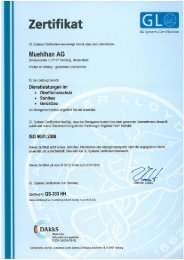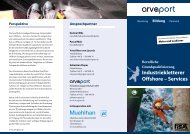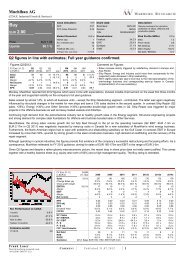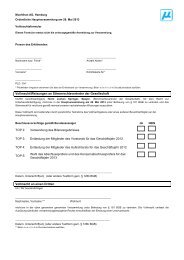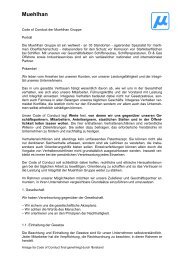Annual Report 2007 - Muehlhan AG
Annual Report 2007 - Muehlhan AG
Annual Report 2007 - Muehlhan AG
Create successful ePaper yourself
Turn your PDF publications into a flip-book with our unique Google optimized e-Paper software.
56<br />
Financial assets held for sale<br />
at the time of acquisition, financial assets are recorded at their acquisition costs (market value) plus related<br />
transaction costs. Subsequent valuation is at fair value (market value). Subsequent changes in value are recorded<br />
in equity (revaluation reserve) in a net effecting operating results manner after taking deferred taxes into account until<br />
the asset is sold or an impairment is recorded with an effect on net income. financial assets held for sale are<br />
shown as financial investments.<br />
Impairment of assets<br />
assets with an indeterminate useful life are not regularly depreciated or amortized. they are subject to an annual impairment<br />
test. tangible fixed assets and intangible assets with a defined useful life are also subject to an impairment test if<br />
there is an indication that the value of the respective asset is reduced. in this connection, the realizable amount (the higher<br />
of net realizable value and service value) is determined and compared with the asset’s carrying amount. if the realizable<br />
value is lower than the carrying amount, the balance is taken to expense. if the reason for the write-down has ceased to<br />
exist in the meantime, a write-up is recorded up to the amortized costs. No such write-up is made with respect to goodwill.<br />
the impairment test is made on the basis of the discounted cash flow method. the expected cash flow is based on<br />
business planning data. its present value is calculated by reference to an interest rate brought about by market forces.<br />
Pension accruals and similar obligations<br />
there are contributory pension plans which do not entail any additional pension obligation except for the current payment<br />
of contributions. there are also defined benefit pension plans at two companies which relate almost entirely to pension<br />
obligations to a retired former managing director of a subsidiary. the pension accruals with respect to the defined<br />
benefit pension plans are calculated in accordance with the projected unit credit method. this actuarial determination of<br />
the present value of accumulated plan benefits does not only take into account the current pension payments and<br />
vested rights of future pension payments at the balance sheet date but also the expected future increase in salaries<br />
and pensions. the 10% corridor method pursuant to iaS 19.92 is applied with respect to actuarial gains or losses. the<br />
accrual is reduced by the amount of potential plan assets. Service and interest costs are shown under personnel<br />
expenses. the actuarial present value of the defined benefit obligation is calculated by discounting the expected<br />
future payments at an interest rate attributable to top-rated corporate bonds denominated in the currency in which<br />
payments have to be made and at maturities matching the pension obligations. in respect of contributory pension plans,<br />
the payments of contributions are shown under personnel expenses. Contributions outstanding at the balance sheet<br />
date are recorded under pension accruals.<br />
Other provisions<br />
in accordance with iaS 37, other provisions are accounted for all risks discernible at the balance sheet date and third-party<br />
liabilities resulting from past transactions or events if the amounts and maturities involved are uncertain. provisions are<br />
based on the best estimate of the amount of the settlement. positive performance contributions are not netted. provisions<br />
are also set up with respect to onerous contracts. a contract is deemed to be onerous if the unavoidable costs exceed<br />
the economic benefit expected from the contract.<br />
Financial liabilities<br />
in principle, financial liabilities are stated at their attributable present value less transaction expenses and carried forward<br />
at amortized cost. Non-interest-bearing or low-interest liabilities with a term of at least one year are accounted for at their<br />
present value taking into account a market-oriented interest rate. liabilities originating from finance leases are accounted<br />
for at the present value of the minimum lease payments at the beginning of the lease transaction or the fair value, if lower,<br />
and reduced by the redemption payments included in the lease rentals.<br />
in principle, short-term financial liabilities include the portion of long-term loans with a term up to one year.



